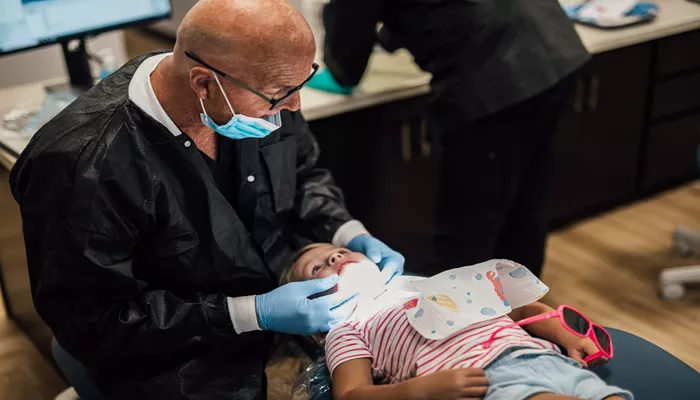The integration of smart technology into the dental field has introduced a new dimension of care, particularly in pediatric dentistry. Smart dentistry leverages advanced technologies to enhance the diagnostic, preventive, and treatment processes, providing a distinct and beneficial experience for children. This article aims to explore the differences in the experience of smart dentistry for children, offering insights into how these innovations can positively impact their dental health and overall well-being.
Enhanced Diagnostic Accuracy and Precision
One of the most significant advantages of smart dentistry for children is the enhanced accuracy and precision in diagnostics. Traditional dental exams often rely on visual inspections and manual probing, which can be subjective and sometimes miss early signs of decay or other dental issues. However, smart dentistry utilizes a range of advanced diagnostic tools, such as intraoral cameras, digital X-rays, and AI-powered analysis software. These tools provide a clearer, more detailed view of the teeth and gums, allowing for earlier detection of problems and more personalized treatment plans.
For children, this means a more thorough and precise understanding of their dental health. Early detection of issues can lead to less invasive and more successful treatments, reducing discomfort and anxiety. Additionally, the use of intraoral cameras can turn the dental exam into a more interactive and educational experience. Children can see their teeth and gums on a screen, which can help them understand the importance of dental hygiene and motivate them to take better care of their teeth.
Personalized Treatment Plans
Smart dentistry also offers personalized treatment plans tailored to the unique needs of each child. Traditional treatment plans often rely on generalized guidelines and protocols, which may not address the specific needs and conditions of individual patients. However, smart dentistry uses advanced technologies to gather detailed data about a child’s dental health, including their bite alignment, tooth spacing, gum health, and more. This data is then analyzed using sophisticated algorithms to create a customized treatment plan that addresses the child’s specific needs.
Personalized treatment plans can lead to more effective and efficient treatments, reducing the need for multiple visits and minimizing discomfort. For children, this means a more streamlined and less stressful dental experience. They can receive targeted treatments that address their specific issues, rather than undergoing general procedures that may not be necessary or effective.
Interactive and Engaging Dental Hygiene Tools
Smart dentistry also incorporates interactive and engaging dental hygiene tools designed to make brushing and flossing more fun and effective for children. Traditional dental hygiene tools, such as toothbrushes and floss, can be monotonous and unappealing to children, leading to poor oral hygiene habits. However, smart dentistry offers a range of innovative products, such as electric toothbrushes with built-in games and apps, smart flossers, and water flossers, that make dental hygiene more interactive and enjoyable.
These tools can help children develop good oral hygiene habits from a young age. They can make brushing and flossing more fun and rewarding, encouraging children to brush for longer periods and more thoroughly. Additionally, some smart dental hygiene tools use sensors and AI to provide real-time feedback on brushing techniques and effectiveness, helping children learn how to brush properly and improve their oral hygiene.
Virtual Consultations and Remote Monitoring
Smart dentistry also offers virtual consultations and remote monitoring, which can be particularly beneficial for children who may experience anxiety or fear when visiting the dentist. Traditional dental visits often require children to travel to a dental clinic, which can be stressful and overwhelming for some. However, smart dentistry allows for virtual consultations, where parents and children can connect with a dentist via video call to discuss concerns, receive advice, and even receive treatment recommendations.
Remote monitoring is another valuable aspect of smart dentistry for children. Advanced technologies, such as wearable sensors and mobile apps, can be used to track a child’s oral health over time. This data can be analyzed by a dentist to identify trends, assess progress, and adjust treatment plans as needed. For children, this means fewer in-person visits to the dentist and more convenience and flexibility in managing their dental health.
Enhanced Patient Education and Engagement
Finally, smart dentistry offers enhanced patient education and engagement, which can be crucial in promoting good oral health habits among children. Traditional dental education often relies on verbal instructions and handouts, which can be forgettable and ineffective. However, smart dentistry uses interactive and multimedia tools, such as augmented reality, virtual reality, and gamification, to make dental education more engaging and memorable.
These tools can help children understand the importance of dental hygiene and learn how to take care of their teeth in a fun and interactive way. For example, augmented reality apps can allow children to visualize the inside of their mouths and see how different dental treatments work. Virtual reality games can simulate dental procedures and help children become more familiar and comfortable with the dental environment. Gamification can turn dental hygiene into a game, encouraging children to earn rewards and achievements for maintaining good oral health.
Conclusion
In conclusion, the experience of smart dentistry is distinctly different for children, offering numerous advantages and benefits. Enhanced diagnostic accuracy and precision, personalized treatment plans, interactive and engaging dental hygiene tools, virtual consultations and remote monitoring, and enhanced patient education and engagement all contribute to a more positive and effective dental experience for children. As technology continues to advance, smart dentistry will play an increasingly important role in promoting good oral health and well-being among children.
Related topics:

